When it comes to painting furniture, the right brush can make all the difference. Whether you’re refreshing an old dresser, transforming a set of chairs, or revamping an antique, the brush you choose plays a crucial role in achieving a smooth, professional-looking finish. While many DIYers are quick to grab any old brush, selecting the best brush to paint furniture is a key part of the process and can save you time, effort, and frustration.
We’ll dive deep into the importance of choosing the right brush for your furniture painting projects. We’ll cover the different types of brushes, factors to consider when choosing a brush, and highlight some of the best brushes available on the market today. Whether you’re a seasoned pro or a first-time furniture painter, this guide will help you get the best results from your efforts.
Why the Right Brush Makes a Difference
Before diving into specifics, it’s essential to understand why the right brush matters. Using the proper brush for your project will:
- Achieve a Smoother Finish: A high-quality brush helps prevent streaks and brush marks, leaving your furniture looking professionally finished.
- Improve Coverage: The right brush ensures an even application of paint, which can reduce the number of coats required and save time.
- Enhance Durability: A good brush allows you to apply the paint more precisely, leading to better adhesion and a longer-lasting finish.
- Reduce Effort and Frustration: Using an appropriate brush for your project makes the painting process easier and more enjoyable, without the constant need to fix mistakes.
Now, let’s look at the types of brushes you can use for furniture painting and how to choose the best one for your needs.
Types of Brushes for Furniture Painting
When selecting a brush for painting furniture, there are several options available, and each type has its advantages depending on the surface, finish, and paint you’re using.
1. Natural Bristle Brushes
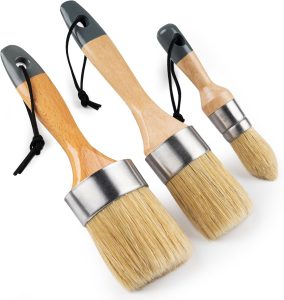
Natural bristle brushes are made from animal hair, such as hog or sable. They are ideal for use with oil-based paints, varnishes, and polyurethane finishes. These brushes tend to have softer bristles, which can create a smooth, even finish on wood surfaces. However, they are not suitable for water-based or latex paints, as the bristles can absorb too much moisture and lose their shape.
Pros:
- Best for oil-based paints
- Soft bristles provide a smooth finish
- Long-lasting and durable
Cons:
- Not compatible with water-based paints
- Higher cost compared to synthetic brushes
2. Synthetic Bristle Brushes
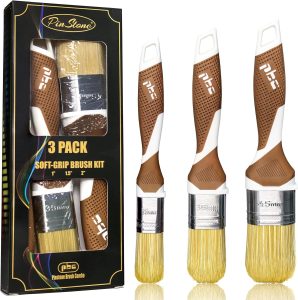
Synthetic brushes are made from nylon or polyester and are perfect for water-based or latex paints. Unlike natural bristles, synthetic brushes do not absorb water, which means they maintain their shape and provide a more consistent finish. These brushes are also more affordable and can be cleaned easily with soap and water after use.
Pros:
- Ideal for water-based and latex paints
- Affordable and easy to clean
- Less shedding than natural bristles
Cons:
- May not be as effective for oil-based paints
- Stiff bristles may leave brush marks if not used properly
3. Foam Brushes
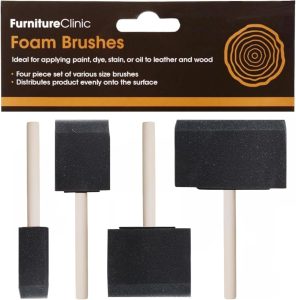
Foam brushes are lightweight and affordable, making them a popular choice for small furniture projects. They work well for applying a smooth, streak-free finish, especially with latex or chalk paint. However, they are not ideal for larger projects, as they tend to wear out quickly and can leave bubbles in the paint.
Pros:
- Inexpensive and easy to use
- Good for smaller furniture pieces
- Works well with latex and chalk paints
Cons:
- Not durable for large projects
- Can leave air bubbles or streaks if not used correctly
4. Purdy and Wooster Brushes
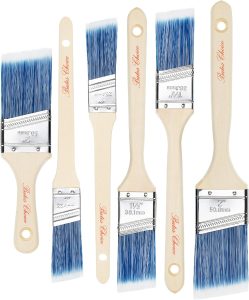
Purdy and Wooster are two well-known brush brands that offer high-quality brushes for furniture painting. These brands are known for producing brushes with excellent bristle retention, a smooth finish, and a comfortable grip. Both brands offer brushes in natural and synthetic bristle options, making them versatile for a variety of projects.
Pros:
- High-quality brushes with great results
- Available in both synthetic and natural bristles
- Durable and long-lasting
Cons:
- Can be more expensive than other brands
- Not all brushes are suitable for every type of paint
5. Chiseled and Angle Brushes
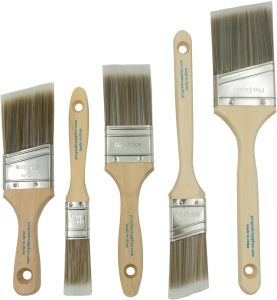
Chiseled or angled brushes are designed to help you achieve a crisp, clean edge when painting furniture. These brushes are especially useful when you need to paint detailed or intricate areas, such as the legs of chairs, the arms of tables, or trim work. They can be used with both latex and oil-based paints.
Pros:
- Perfect for detailed work
- Provides clean lines and edges
- Works with both latex and oil-based paints
Cons:
- Not ideal for large, flat surfaces
- Requires precision and control to avoid uneven lines
Factors to Consider When Choosing the Best Brush for Painting Furniture
When selecting the best brush for your furniture painting project, several factors will influence your decision. Let’s break them down:
1. Type of Paint
The type of paint you’re using is one of the most critical factors when choosing a brush. For oil-based paints, natural bristle brushes are often the best choice, as they offer a smooth finish and excellent paint retention. If you’re working with water-based or latex paints, synthetic brushes (made of nylon or polyester) are the better option, as they won’t absorb water and lose their shape.
2. Size of the Brush
The size of the brush you use depends on the size of the furniture you’re painting. For larger surfaces, such as tabletops or large cabinets, a wide brush with a lot of bristle coverage is ideal. Smaller brushes are better suited for painting smaller areas, details, or trim work, such as chair legs, cabinet doors, or intricate moldings.
3. Bristle Quality
A good-quality brush will have bristles that retain their shape, hold paint well, and provide a smooth finish. Look for brushes with high-density bristles that won’t shed or leave streaks in the paint. Natural bristles are softer and are better suited for oil-based paints, while synthetic bristles tend to hold their shape better with water-based paints.
4. Handle Comfort
Painting furniture often takes time and effort, so it’s important to choose a brush with a comfortable handle. A well-designed handle will allow you to have better control over the brush, reducing hand fatigue and making the painting process easier. Look for brushes with ergonomic handles that fit comfortably in your hand.
5. Durability and Reusability
If you plan to paint multiple pieces of furniture or expect to do frequent DIY painting projects, investing in a durable, high-quality brush will save you money in the long run. High-quality brushes like those from Purdy, Wooster, or other reputable brands are known for their longevity, making them a good investment.
Top Brushes for Painting Furniture
To help you find the best brush for your furniture painting projects, here are some of the top-rated brushes that consistently receive positive reviews from DIYers and professionals alike:
1. Purdy XL Elite Glide Brush
The Purdy XL Elite Glide Brush is a top choice for furniture painters who need a high-quality, durable brush for both latex and oil-based paints. Its synthetic bristles provide a smooth, streak-free finish, and the ergonomic handle makes it comfortable for extended use.
Best for: Water-based paints, furniture with large surfaces
2. Wooster Shortcut Angle Brush
The Wooster Shortcut Angle Brush is perfect for detailed work. With its angled bristles, this brush is ideal for painting furniture trim, edges, and hard-to-reach areas. The short handle offers better control, and its synthetic bristles work well with both oil and water-based paints.
Best for: Detail work, trim, and intricate areas
3. Zibra Painting Brush (Square Top)
Zibra’s Square Top Brush offers excellent control and coverage for smaller furniture projects. The unique design of the brush makes it easy to get into corners, edges, and hard-to-reach spaces. It works well with a variety of paints, including latex, chalk, and milk paint.
Best for: Smaller pieces of furniture, edges, and corners
4. Annie Sloan Brushes
Annie Sloan is renowned for her chalk paint, and her brushes are designed specifically for use with her products. These brushes are durable, easy to clean, and offer a smooth application, making them a great choice for furniture painting projects.
Best for: Chalk paint, vintage furniture projects
5. Purdy Monarch Elite Brush
Another excellent option from Purdy, the Monarch Elite Brush is designed for a flawless finish with oil-based paints. It is ideal for larger furniture surfaces, providing excellent coverage and a smooth application. The high-quality natural bristles ensure a professional result.
Best for: Large furniture pieces, oil-based paints
Frequently Asked Questions
- What type of brush is best for painting furniture?
The best brush for furniture painting depends on the type of paint you’re using. For water-based paints, synthetic brushes are the best choice, while oil-based paints require natural bristle brushes. - Can I use a foam brush for furniture painting?
Foam brushes work well for small projects or applying thin coats of paint, but they may not be the best option for larger furniture pieces as they can wear out quickly and leave bubbles. - How do I avoid brush marks when painting furniture?
To avoid brush marks, use a high-quality brush, apply thin coats of paint, and allow each coat to dry fully before applying the next one. Smooth, even strokes are key to a streak-free finish. - How do I clean a brush after painting furniture?
For water-based paints, clean your brush with soap and water. For oil-based paints, you’ll need to use mineral spirits or paint thinner to clean the brush thoroughly. - Should I buy an expensive brush for painting furniture?
While high-quality brushes can be more expensive, they provide better results, last longer, and make the painting process easier. Investing in a good brush is worth it, especially if you plan to paint furniture regularly. - Can I paint furniture without sanding it first?
While sanding furniture is usually recommended to ensure a smooth surface and better paint adhesion, some paints (like chalk paint) don’t require sanding. However, sanding may still help create a more professional finish. - How many coats of paint should I apply to furniture?
Generally, two coats of paint are sufficient for most furniture painting projects. However, the number of coats may vary depending on the type of paint, the color you’re applying, and the surface you’re painting.
Conclusion
Selecting the best brush for painting furniture is essential to achieving a professional-looking finish. Whether you’re working with latex, chalk, or oil-based paints, the right brush ensures smooth, even coverage, reduces brush marks, and helps create a durable finish. By considering the type of paint, brush size, bristle quality, and the project you’re working on, you can find the perfect brush for your furniture painting needs.
With the right tools and a little patience, you’ll be able to transform any piece of furniture into a beautiful, custom piece that enhances your home’s decor. Happy painting!

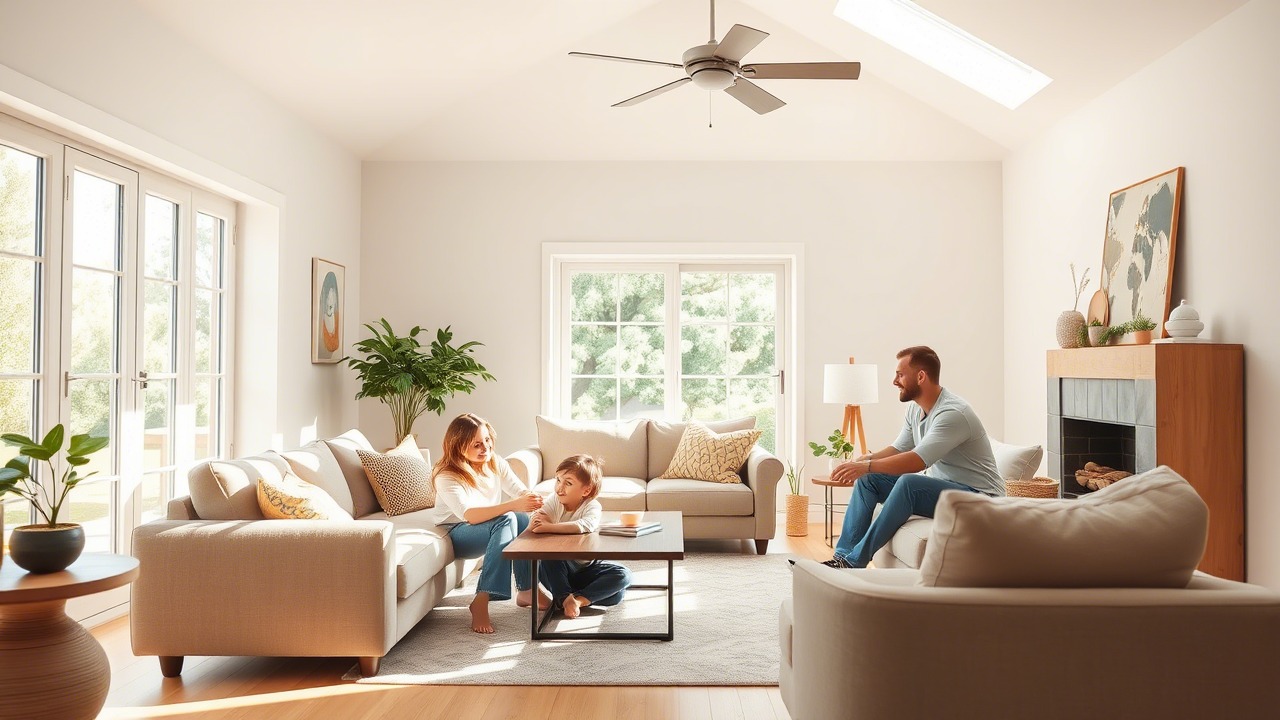
Leave a Reply